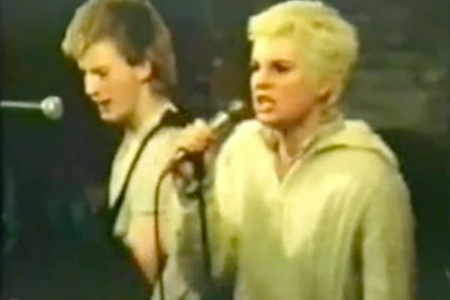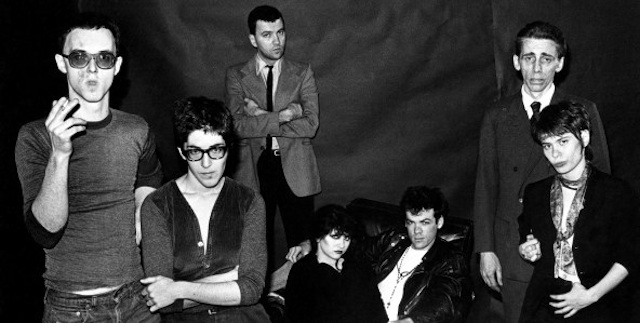
Not long ago editors Zack Carlson and Bryan Connolly published Destroy All Movies!!!, a doorstop-heavy labor of love billed as “the complete guide to punks on film.” This was truth in advertising, as the reader would be pretty hard pressed to think of a single big-screen title in which a “punk” character or real-life figure made even a fleeting appearance that the tome didn’t duly include and explain.
The vast majority of its entries, however, offered not so much reflections of the actual 1970s and ’80s punk scene, but rather the distortions and caricatures of “punks” in commercial movies of the era. For every inaccurate but sympathetic depiction like Nic Cage’s scruffy suitor to Valley Girl, there were a dozen or more movies like Class of 1984, Savage Streets or Death Wish 3—exploitation flicks in which the likes of Charles Bronson or Linda Blair were called upon to protect society from thieving, raping, helpless-old-lady-killing “punk” hoodlums.
Whether pseudo-punk imagery surfaced in Z-grade trash or mainstream Hollywood product, it was almost invariably used to milk the same negative response most ordinary Americans had to it in real life. Sure, by the mid-’80s New Wave acts had crept into the Top 40. But even then, wearing a mohawk wasn’t the mere fashion statement it is today, but something that many others took as an invitation to a fistfight.
Whether pseudo-punk imagery surfaced in Z-grade trash or mainstream Hollywood product, it was almost invariably used to milk the same negative response most ordinary Americans had to it in real life. Sure, by the mid-’80s New Wave acts had crept into the Top 40. But even then, wearing a mohawk wasn’t the mere fashion statement it is today, but something that many others took as an invitation to a fistfight.
The real punk scene was being documented, all right, but not in any way you could see at the multiplex or drive-in. A bare handful of features like The Decline of Western Civilization or the British Rude Boy provided an alternative to the pop-culture stereotypes, but they weren’t seen beyond a few urban arthouses and campus screenings. Even less accessible were a whole underground of 8mm, 16mm and video missives by and for the scene itself—the D.I.Y. aesthetic in cinematic practice, creating makeshift movies of variable length that were sometimes shown at clubs, on public access TV, or passed around on VHS dupes.
The Internet has made many (though by no means all) of them easier to find than ever before. But theatrical revival screenings are as rare as snow leopards. Ergo the capital of punk nostalgia this weekend will be San Francisco, where the Roxie Cinema has programmed a three-day series of ultra-rarities entitled “This Must Be the Place: Post-Punk Tribes 1978-1982.”
By 1978 America thought it knew what punk was—The Sex Pistols, namely, who combusted early that year (ending with a disastrous final gig in San Francisco, actually) and had already been proclaimed an empty hype, a public menace and a commercial flop by our mainstream media. But once the publicity died down a bit, it became clear to those with more than an eye-blink attention span that punk (which some argued started here anyway, via Richard Hell and The Ramones) had actually seeded itself all around the country. Regional scenes would start to flourish, welcoming any and all misfits united by boredom with the complacent ’70s rock industry and society in general.
These “tribes” fostered some great bands, some good if little-remembered ones, and many more not worth remembering save as a slice of someone’s passing experience. Punk, like soon-to-be-emerging hip hop, wasn’t strictly musical but multimedia, sparking an outpouring of creativity not just on stage and on vinyl but in photocopied collage art, handmade ’zines, and more.

Plus film, of course. Céline Danhier’s documentary Blank City chronicles the subterranean punk-inspired cinema that erupted from New York City at the time. But of course, anything artistic that happens in Manhattan is sure to magnetize a thousand thesis papers and a few documentaries eventually. The Roxie series fascinates partly because it moves beyond the official birthplaces of punk to show what was happening well off the beaten track.
San Francisco indeed had its own highly active punk community early on, though it was never given its national due thanks to the usual media focus on NYC and Los Angeles. An invaluable snapshot is provided by Louder, Faster, Shorter, a 1978 “maga-film” from Search & Destroy, the local ‘zine that turned into alternative publishing house Re/Search. Sampling two nights of punk bands at North Beach’s Mabuhay Gardens that year, it provides a rare live glimpse of legendary Bay Area acts Avengers, The Mutants and The Dils, among others—as well as evidence that our punk scene was more gender-integrated than many others. Also on the Roxie’s S.F.-oriented Saturday program are Liz Keim and Karen Merchant’s scene stock-taking In the Red, as well as shorts and a slideshow of still photographs from Bruce Conner, the late experimental film luminary who was drawn to the punk milieu alongside people half his age or less.
The L.A. punk underground was very young (often underage), testosterone-fueled, different sectors happy to pick fights with one another. It naturally became home to what was probably (at least at first) the country’s premiere hardcore scene, as captured by future Desperate Teenage Lovedolls director Dave Markey in 1982’s The Slog Movie. This cheerfully slapdash document captures TSOL, Circle Jerks, Circle One, Black Flag and Wasted Youth on and sometimes offstage in a home-movie-like memento of youth gone wild. It’s not quite Another State of Mind (1984)—perhaps the definitive hardcore lifestyle record, and one of the greatest of all punk documentaries—but these 59 minutes will nonetheless make you wish you’d been there.
‘Debt Begins at 20,’ Stephanie Beroes’ mix of vérité and staged footage, captures “alternative” culture in Cincinnati, 1980 A.D. Using defiantly uncharismatic drummer (for The Cardboards) and layabout Bill Bored as its protagonist, it vividly conveys what it was like to live in cities that got their notions of punk second or third-hand at the time—the snarky one-joke artschool-type bands imitating Devo, the disappointing parties, the lack of anything to do, all while surrounded by armies of AC/DC and Loverboy fans.
Not so much Debt Begins at 20, Stephanie Beroes’ mix of vérité and staged footage capturing “alternative” culture in Cincinnati, 1980 A.D. Using defiantly uncharismatic drummer (for The Cardboards) and layabout Bill Bored as its protagonist, it vividly conveys what it was like to live in cities that got their notions of punk second or third-hand at the time—the snarky one-joke artschool-type bands imitating Devo, the disappointing parties, the lack of anything to do, all while surrounded by armies of AC/DC and Loverboy fans.
This is a far cry from the period’s records from New York and London, where it could be taken for granted that something exciting was going on—and that one ought to be jaded about it. 1982’s Rough Cut and Ready Dubbed by Hasan Shah and Dom Shah takes measure of a English punk scene pronounced dead even by those who adhere to its style. The cynicism that time and commercial success brings has duly landed—thanks in no small part to the ever-fickle U.K. music press—with blokes and birds on the street debating who’s “sold out” while musicians protest that what’s “selling out” to others is to them simply, finally being able to make a living off their art. Among first and second-wave bands heard from here are Stiff Little Fingers, UK Subs, Cockney Rejects and Sham 69, with a more sonically diverse future heralded by ska-fueled Selecter and Factory Records act A Certain Ratio.
In New York City, naturally, capturing the scene’s flourishing diversity required a fictive quasi-narrative drawing figures from all art forms with some street cred. Edo Bertoglio’s Downtown 81 casts the late painter Jean-Michel Basquiat as…himself, more or less, an innocent plunging down the rabbit hole of Manhattan’s avant-garde. Among the exotic figures he encounters en route are No Wavers like James White, pioneering rapper Fab 5 Fred, and even Blondie’s Debby Harry as a bag lady turned Fairy Godmother.
Likewise, a semblance of conventional feature packaging cushions the culture shock in Philippe Pulcouyoul’s 1980 La Brune et Moi, even if this “lost New Wave classic” was barely seen until a print was found and restored a few years ago. Its wafer-thin plotline (Parisian punk princess Anoushka takes Pierre Clementi’s uptight suit on wild-side walk) is an excuse to preserve performances by many of France’s greatest underground acts of the moment, including Go-Go Pigalles, Edith Nylon, Questions, Ici Paris, and more.
If you can’t recall Paris being on the punk map back then, prepare for an even greater shock with the Roxie’s “special secret movie” late Friday night. We can’t reveal the title, but suffice it to say this feature documentary about one very cold but surprisingly hot (musically speaking) Nordic capitol in the early 1980s offers a very early, pre-‘cube glimpse of a certain spritely female later turned actress for Lars von Trier (and consort for Tricky and Matthew Barney).
Last but not least, Saturday’s “Buzz or Howl Under the Influence” program (named after a 1983 Minutemen EP) offers a smorgasbord of miscellaneous vintage punk artifacts—much of it shown courtesy of the Hugh M. Hefner Archive of the Moving Image. Playboy preserving punk’s legacy? Well, at a time when one presidential candidate has promised to put pornography filters in every American’s computer, I guess Hef’s commitment to freaks and free expression can indeed be considered sorta punk.



